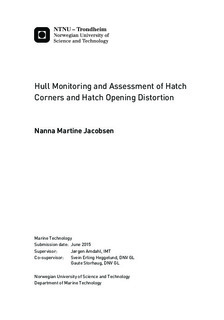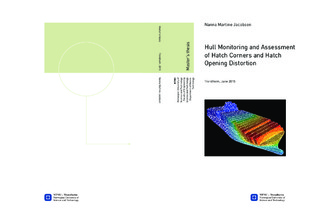| dc.description.abstract | Torsion is highly important for large container carriers. In order to maximize the
container capacity, a large deck area is essential, which often leads to a big bow
are. To simplify loading and ooading, each cargo hold is equipped with huge
hatch openings. These large deck openings, with slender longitudinal and transverse
deck strips, will deform due to torsion in oblique seas, referred to as hatch
opening distortions. This is regarded a vital strength aspect for container carriers.
A master project is performed, in order to investigate how torsion contributes to
extreme loading. Full scale measurements of a 8600 TEU container vessel, conducted
by DNV GL, theoretical methods, and a global and a local Finite Element
(FE) model have been used for this purpose. This was done, to get a greater
knowledge of torsional behaviour of container carriers, which again can be used to
document whether torsion should be included in ship design rules.
The ship has been operating on two dierent trades. On Route 1, the vessel follows
a relatively sheltered passage from Hamburg to Singapore, whereas the vessel
crosses the North Pacic Ocean from Singapore to USA on Route 2. Results
from a hydrodynamic analysis, and environmental data for each route, was used
to calculate the long term distribution of longitudinal stresses in deck. Long term
distribution of deck stresses veries that Route 2, which is known for more rough
seas, gives the worst prediction of stresses. However, the measured stresses prove
dierent. In order to nd out why measured stresses are higher for Route 1, although
Route 2 has more rough seas, the vessel's operating speed was investigated.
It was found that the vessel operates at higher speeds on Route 1, than on Route
2. With speed reduction, the ship resistance, and the risk for occurrence of high
stresses due to wave induced vibrations, such as whipping, springing and torsional
vibrations, is lowered. Additionally, no signicant routing has been observed on
the rst route. On the second route, on the other hand, routing was found, i.e.
the roughest seas have been avoided. This will again inuence and lower measured
stresses. Speed reduction and routing are therefore important reasons why measured
stresses are lower on Route 2, than Route 1, despite the fact that the wave
environment is more rough on Route 2.
Measurement data have been investigated to evaluate the degree of torsional vibrations present. During the day where most torsion is measured, the ratio of
dynamic and wave stresses ~ 1.10, which indicates that the ship does not experience
signicant torsional vibrations. Thus, torsional vibrations are found to be of
minor concern for the 8600 TEU vessel.
Global FE-analyses of the container vessel have been performed, with respect to the yielding criteria for Ultimate Limit State, ULS, due to torsion. Additionally,
since many modications were done in order to analyse the model, self-checks of
the model with vertical and horizontal bending moments were carried out. A
coarse mesh was used to obtain nominal stresses. Rule stresses with respect to
ULS were found by applying torsional moments, calculated from ship rules. The
results show that maximum measured stresses in the deck strip are approximately
0.69-0.74 of ULS rule stresses for Route 1 and 0.63-0.68 on Route 2, i.e. measured
stresses are within the acceptance criteria for ULS, on both routes.
Since local stresses may be included in the measurements, the same analysis of
the transverse deck strip was performed with ne mesh. Local stresses, and thus
measured stresses, were found to be about 10 - 15 % higher than nominal stresses.
The local stresses in the measurements are most likely due to the fact that the
sensors are located close to hatch corners and close to a weld between two deck
plates, which are source to stress concentrations, i.e. hot spot stresses.
The magnitude of the hatch opening distortion has been calculated from the global
FE-model. It was found that hatch opening distortion, due to the maximum measured
stress of 131 MPa (measured on Route 1), has a magnitude of 226 mm. In
comparison, the expected hatch opening distortion due to estimated ULS stresses
is 335 mm at the deck strip where the sensors are located. The largest ULS hatch
opening distortion obtained is located further forward, at cargo hold 3, where the
deformations reaches 411 mm.
The calculations were also done simplied, with use of hand calculations, 3D-Beam,
and a deck strip model. This, to nd out if simplied and less time consuming
methods can be used in later studies of hatch opening distortions, or if a global
model must be used for this purpose. Values for hatch opening distortion for the
simplied calculation methods are between 7 - 21 % lower than calculated from
the global model. If further studies of other container ships gives the same relation
between the simplied methods and the global model, simplied methods might
be used, introducing a scaling factor. | |

